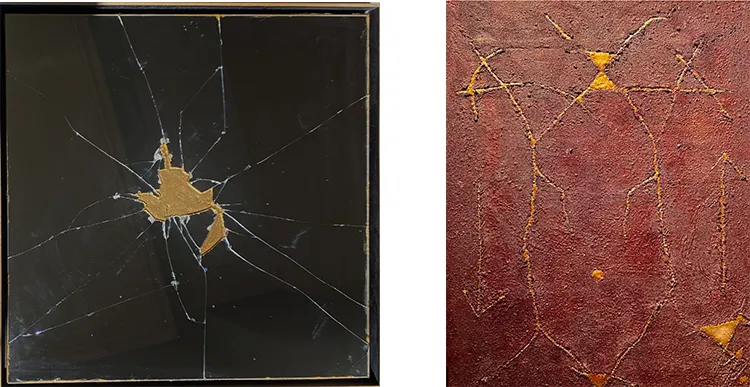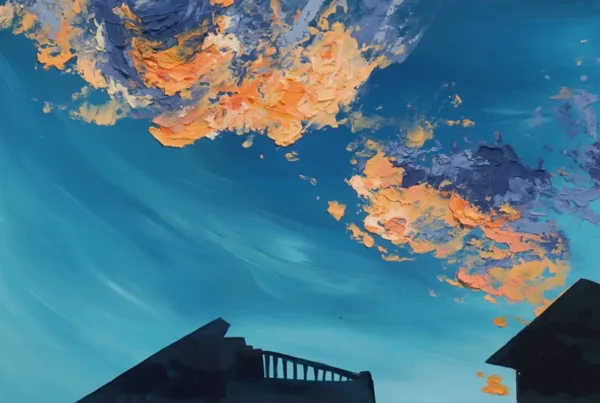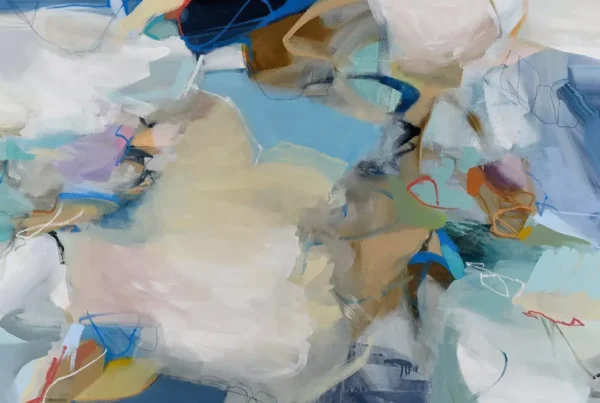“I have managed to bring light where there is none.”
ATo’: A Journey Through Matter and Emotion
Anna Tozzi, known in the art world as ATo’, has forged a distinctive artistic path that intertwines material exploration with deep emotional expression. Her journey began in the realm of graphic design and advertising, where she honed her technical skills in various studios. However, she soon realized that her true calling lay in the unfiltered language of pictorial art—an avenue through which she could explore her identity and convey her inner world. This relentless pursuit of self-discovery has shaped her creative evolution, leading her to develop a highly tactile and unconventional painting technique.
At the heart of her artistic practice is an experimental approach to materials. For years, she has explored the expressive potential of acrylic and PVA glue, applying them to canvas in a process that is as unpredictable as it is intentional. Using brushes and spatulas, she guides the flow of color and texture, allowing the painting to take form organically as it dries. The final composition is never predetermined; instead, it emerges from the interplay of matter and time, with cracks and fissures revealing an imprint of her emotional state. This ever-changing process mirrors Tozzi’s own artistic spirit—fluid, evolving, and deeply introspective.
Her early works focused on textured surfaces that concealed underlying layers, evoking the passage of time and the hidden depths beneath seemingly impenetrable exteriors. Over time, her focus shifted to painting fractured walls and worn streets—scenes marked by age and decay yet illuminated by the luminous presence of gold. “I have managed to bring light where there is none,” she states, encapsulating the essence of her artistic philosophy. This exploration of deterioration and renewal continues to define her practice, leading her to incorporate new materials such as cement, clay, ceramic, and sand in her ongoing investigations into form and substance.
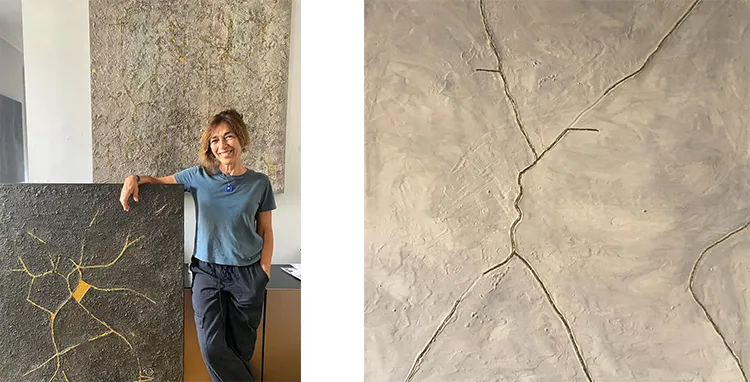
Anna Tozzi: Transforming Ruins into Gold
Tozzi’s fascination with imperfection and restoration has driven her to experiment with unconventional materials, pushing the boundaries of traditional painting. Her most recent work, Dentro e Fuori, exemplifies this evolution, incorporating an intricate blend of cement, marmorino, and other raw elements. This fusion of materials lends her paintings a sculptural quality, blurring the line between two-dimensional composition and relief-like texture. The physicality of her work invites viewers to engage not only visually but also on a tactile level, as if each piece were an artifact unearthed from a forgotten past.
One of her most striking techniques involves breaking and reassembling mirrors, binding the fractured shards with glue and gold dust. This act of destruction and reconstruction serves as a metaphor for resilience and transformation, echoing the Japanese art of Kintsugi, where broken pottery is repaired with gold to highlight its history rather than conceal its flaws. In a similar vein, her Islands series reclaims discarded fragments of asphalt from the streets, piecing them together with gold to create compositions that reflect both urban decay and the enduring beauty found within destruction.
Her work is deeply influenced by artists who embrace the power of a single gesture or mark—Burri’s burned surfaces, Fontana’s slashed canvases, Rothko’s meditative color fields. Like these visionaries, Tozzi aspires to distill raw emotion into a single expressive act, using her chosen materials to evoke themes of time, memory, and transformation. Whether through a crack, a cut, or the delicate placement of gold within fractured forms, her art seeks to capture the fleeting yet profound essence of human experience.
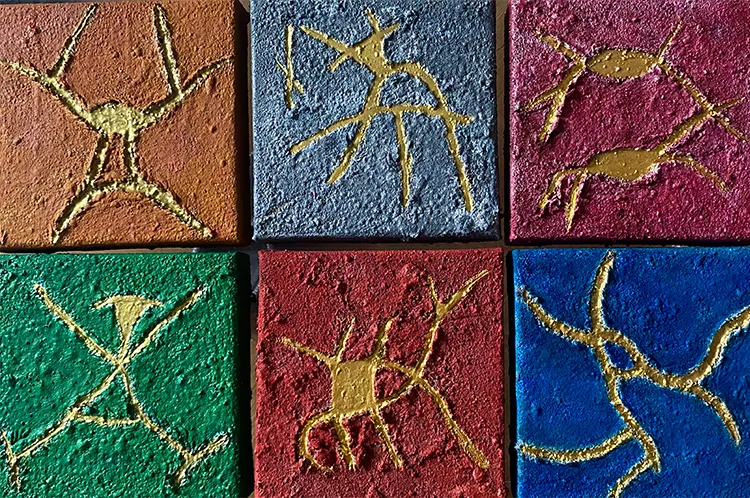
The Language of Texture and Time
Tozzi’s paintings transcend conventional abstraction by integrating materials that evoke a sense of history, erosion, and renewal. Her surfaces, often cracked, fragmented, and layered with traces of past interventions, resemble relics from an ancient civilization. This synthesis of contemporary abstraction with archaic symbolism creates a compelling tension—one that speaks to both the transient nature of existence and the enduring power of creation.
Gold plays a central role in her work, not merely as an aesthetic choice but as a conceptual device. Applied to areas of breakage and decay, it transforms what might otherwise be seen as damage into something sacred. This interplay of the raw and the refined, the worn and the luminous, establishes a visual dialogue between destruction and beauty. The stark contrast between her use of dark, earthen tones and the brilliance of gold heightens the sense of duality—entropy versus renewal, fragility versus permanence.
Some of her compositions feature abstract, petroglyph-like markings, suggesting connections to ancient storytelling and primordial symbols. Others embrace geometric divisions and fractured structures that seem to document the passage of time. Through her use of shattered glass, rough stone-like textures, and metallic elements, her paintings attain a sculptural presence, inviting the viewer to perceive them as more than just images, but as objects imbued with history and transformation.
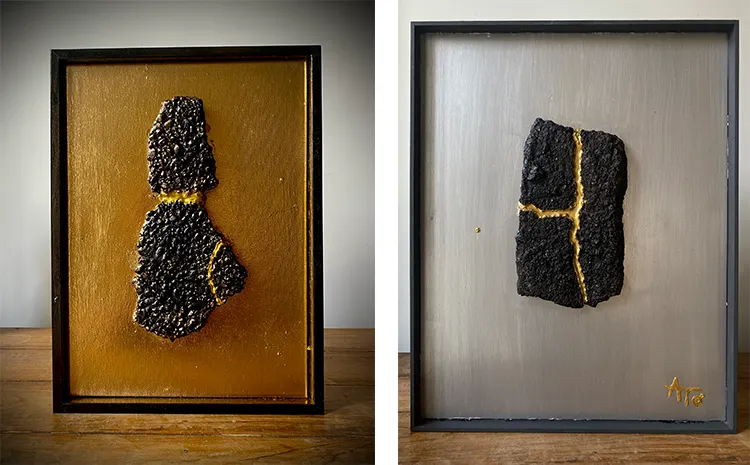
Anna Tozzi: Art as an Act of Reconstruction
Tozzi’s artistic vision is rooted in an almost meditative reverence for imperfection. Her process embraces the beauty of brokenness, reinforcing the idea that destruction is not an end but a beginning. By physically deconstructing and reassembling materials, she creates works that are not just visually striking but also deeply symbolic of renewal and resilience. Her ability to transform mundane or discarded materials into something poetic elevates her practice beyond mere aesthetic exploration—it becomes an act of reclamation and transcendence.
Her engagement with Art Informel and Abstract Expressionism is evident, yet her work carries a distinctive sensibility that feels both deeply personal and universally resonant. The unpredictability of her materials, the slow revelation of textures, and the interplay between deliberate action and spontaneous formation make her art a compelling exploration of process and meaning. In each crack, each fragment, and each golden repair, she captures the essence of imperfection not as a flaw, but as a testament to endurance and transformation.
Through her work, Tozzi invites the viewer to reconsider notions of damage and restoration, urging them to find beauty in the unexpected. Her paintings are not merely compositions but living entities, evolving through time, material, and intent. Just as the fissures in her work reveal glimpses of gold, her art offers a profound reminder: within every break, there is the potential for something luminous to emerge.
